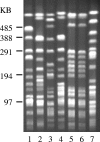SME-3, a novel member of the Serratia marcescens SME family of carbapenem-hydrolyzing beta-lactamases
- PMID: 17005839
- PMCID: PMC1610102
- DOI: 10.1128/AAC.00363-06
SME-3, a novel member of the Serratia marcescens SME family of carbapenem-hydrolyzing beta-lactamases
Abstract
Imipenem-resistant Serratia marcescens isolates were cultured from a lung transplant patient given multiple antibiotics over several months. The strains expressed SME-3, a beta-lactamase of the rare SME carbapenem-hydrolyzing family. SME-3 differed from SME-1 by a single amino acid substitution of tyrosine for histidine at position 105, but the two beta-lactamases displayed similar hydrolytic profiles.
Figures

Similar articles
-
SME-2-producing Serratia marcescens isolate from Switzerland.Antimicrob Agents Chemother. 2007 Jun;51(6):2282-3. doi: 10.1128/AAC.00309-07. Epub 2007 Apr 9. Antimicrob Agents Chemother. 2007. PMID: 17420208 Free PMC article. No abstract available.
-
SME-type carbapenem-hydrolyzing class A beta-lactamases from geographically diverse Serratia marcescens strains.Antimicrob Agents Chemother. 2000 Nov;44(11):3035-9. doi: 10.1128/AAC.44.11.3035-3039.2000. Antimicrob Agents Chemother. 2000. PMID: 11036019 Free PMC article.
-
Occurrence of an SME-2-producing Serratia marcescens isolate in Canada.Int J Antimicrob Agents. 2008 Feb;31(2):181-2. doi: 10.1016/j.ijantimicag.2007.10.007. Epub 2007 Dec 20. Int J Antimicrob Agents. 2008. PMID: 18083009 No abstract available.
-
Class A carbapenemases.J Antimicrob Chemother. 2007 Sep;60(3):470-82. doi: 10.1093/jac/dkm226. Epub 2007 Jun 26. J Antimicrob Chemother. 2007. PMID: 17595289 Review.
-
[Development of Beta-lactamase resistance in enterobacteria].Klin Mikrobiol Infekc Lek. 2006 Jun;12(3):103-7. Klin Mikrobiol Infekc Lek. 2006. PMID: 17051471 Review. Slovak.
Cited by
-
Structural basis for carbapenem-hydrolyzing mechanisms of carbapenemases conferring antibiotic resistance.Int J Mol Sci. 2015 Apr 29;16(5):9654-92. doi: 10.3390/ijms16059654. Int J Mol Sci. 2015. PMID: 25938965 Free PMC article.
-
Detection of Carbapenemase Production in Gram-negative Bacteria.J Lab Physicians. 2014 Jul;6(2):69-75. doi: 10.4103/0974-2727.141497. J Lab Physicians. 2014. PMID: 25328329 Free PMC article.
-
Dissemination of the Klebsiella pneumoniae carbapenemase in the health care settings: tracking the trails of an elusive offender.mBio. 2011 Dec 20;2(6):e00280-11. doi: 10.1128/mBio.00280-11. Print 2011. mBio. 2011. PMID: 22186612 Free PMC article.
-
Activity of Imipenem-Relebactam and Meropenem-Vaborbactam against Carbapenem-Resistant, SME-Producing Serratia marcescens.Antimicrob Agents Chemother. 2020 Mar 24;64(4):e02255-19. doi: 10.1128/AAC.02255-19. Print 2020 Mar 24. Antimicrob Agents Chemother. 2020. PMID: 31932381 Free PMC article.
-
Genetic and Biochemical Characterization of FRI-1, a Carbapenem-Hydrolyzing Class A β-Lactamase from Enterobacter cloacae.Antimicrob Agents Chemother. 2015 Dec;59(12):7420-5. doi: 10.1128/AAC.01636-15. Epub 2015 Sep 21. Antimicrob Agents Chemother. 2015. PMID: 26392482 Free PMC article.
References
-
- Bush, K., and S. B. Singer. 1989. Effective cooling allows sonication to be used for liberation of β-lactamases from gram-negative bacteria. J. Antimicrob. Chemother. 24:82-84. - PubMed
-
- Clinical and Laboratory Standards Institute. 2006. Methods for dilution antimicrobial susceptibiltiy tests for bacteria that grow aerobically; approved standard, 7th ed. Approved standard M7-A7. Clinical and Laboratory Standards Institute, Wayne, Pa.
-
- Gales, A. C., D. J. Biedenbach, P. Winokur, D. M. Hacek, M. A. Pfaller, and R. N. Jones. 2001. Carbapenem-resistant Serratia marcescens isolates producing Bush group 2f β-lactamase (SME-1) in the United Sates: results from the Mystic Programme. Diagn. Microbiol. Infect. Dis. 39:125-127. - PubMed
MeSH terms
Substances
LinkOut - more resources
Full Text Sources
Medical

